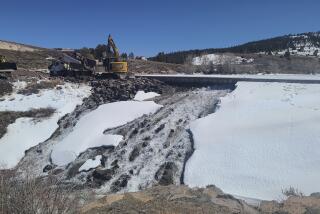‘Get out now!’ Public warned as Harvey strains Houston’s dams and levees

Swollen with days of record rainfall from Tropical Storm Harvey, a 70-year-old dam overflowed and a levee leaked Tuesday, sending water coursing into nearby neighborhoods in Houston and a southwestern suburb.
Despite controlled releases by the U.S. Army Corps of Engineers, the water level of Addicks Reservoir in northwest Houston rose past the dam’s gates for the first time in its history, rising more than 10 inches past the spillway. The neighboring Barker Reservoir also was at risk of overflow.
In Brazoria County, in the southwestern corner of greater Houston, rainwater began to ooze through a levee and into the Columbia Lakes subdivision, prompting county officials on Twitter to warn residents to “Get out now!!”
The levee, which is maintained by the subdivision, was “temporarily patched” several hours later, County Judge Matt Sebesta said in an interview.
“We’re hoping that it will hold,” said Sebesta, the county’s top government official. “But water will still be very high in that area, so there is a chance it will come over the top of the levee.”
More than 100 subdivisions across the region are under voluntary evacuation orders due to flooding, and the number is expected to rise. Some neighborhoods are expected to receive 50 inches of rain during Harvey — as much as Houston sees in a typical year.
On Monday, the corps began releasing water from the Barker and Addicks facilities and into the Buffalo Bayou.
But by Tuesday, the Addicks Reservoir had filled, and water was pouring at an uncontrolled rate over an emergency spillway. Water was also flowing around the back of the wedge-shaped reservoir into the neighborhood.
That created the risk of eroding the sides of the reservoir, which would increase spillage, said Don Riley, the retired chief of civil works at the Army Corps of Engineers.
“I would pray that rain stops,” Riley said.
Despite the releases, the water line at the Barker Reservoir was rising faster than expected. The reservoir is still expected to overflow, corps officials said — though exactly when is unknown, because both reservoirs’ gauges flooded Monday night, said Jeff Lindner, Harris County’s flood control meteorologist.
The corps had assured the public before the storm that there was little chance that the dams would overflow.
“There goes another prediction,” said Robert Bea, an emeritus professor at UC Berkeley’s civil engineering department who investigated the failure of levees during Hurricane Katrina. “It is a very risky situation.”
Tuesday afternoon, Dave Cervera, 45, stood on the Barker Reservoir dam and took a long look toward his neighborhood, which he had just evacuated.
In front of him was the bayou, which had risen out of its banks and flooded his neighborhood, Briarhills. Trees, machine shops and industrial buildings stood immersed in water, with homes barely visible beyond.
“I’m not expecting anything left after seeing this,” Cervera said.
I’m not expecting anything left after seeing this.
— Dave Cervera, Harris County resident
Before the corps released the water, Col. Lars Zetterstrom, Galveston District commander, defended the action in a statement: “If we don’t begin releasing now, the volume of uncontrolled water around the dams will be higher and have a greater impact on the surrounding communities.”
Some subdivisions would see flooding, Zetterstrom said, but Addicks and Barker should continue to perform “as designed,” preventing the flooding of downtown Houston.
Farther downstream from the dam’s release point, bystanders gathered at intersections to look at the water. The area mostly lacked the dramatic rescue scenes elsewhere in the Houston area. The releases of the reservoirs were not visible to them. It just looked like another flooded street.
“I’m not happy about it,” Christina Kelley, 41, an Army veteran and a resident of a downstream neighborhood, said of the reservoir releases. “But I trust the Corps of Engineers.... They’re trained people that know what they’re doing and they have our safety at heart.”
The Addicks and Barker dams were considered among the world’s longest when they were conceived after disastrous floods in 1929 and 1935.
When they were built, more than 70 years ago, Addicks and Barker occupied vacant fields far from the city center. But Houston’s sprawl has long since enveloped both structures, surrounding them with suburban neighborhoods.
The twin reservoirs remain dry about 90% of the time and are designed to send runoff and rainwater coursing into the Buffalo Bayou — away from downtown Houston and the Houston Ship Channel.
Several years ago, the corps designated Addicks and Barker as “extremely high risk,” citing specific concerns about the water release structure and the ends of the dams.
Last year, corps officials assured residents that Houston was not “in imminent danger of flooding” from either dam.
A $75-million effort to replace the aging dam gates is less than 15% complete.
Authorities who oversee Lake Conroe, another reservoir, also had to decide whether to release water. The San Jacinto River Authority had opted not to release water from the lake in advance of Harvey because it could have caused flooding before the storm, spokeswoman Ronda Trow said.
But by Monday, the authority had no choice but to open the floodgates, sending 79,141 cubic feet of water into north Houston every second.
In Brazoria County, officials remained on edge. The rural and suburban county borders the Brazos and San Bernard rivers, which were swollen with rain. Parts of the county had been under a mandatory evacuation order since Sunday morning.
By Tuesday afternoon, the San Bernard had risen to more than 14 feet over flood stage, and the Brazos reached nearly 11 feet over flood stage.
“Waters will rise faster,” Sebesta said. “They will accelerate through the flood plain faster. People need to be prepared to go.”
For more transportation news, follow @laura_nelson on Twitter.
Times staff writer Ralph Vartabedian contributed to this report.
ALSO
Gulf Coast braces for more rain as Harvey makes second landfall
With the Brazos River headed for an off-the-charts flood, a Texas neighborhood is on the run
UPDATES:
6:45 p.m.: This article was updated to report that the Army Corps of Engineers designated the Addicks and Barker reservoirs “extremely high risk” several years ago.
5:20 p.m.: This article was updated with comments from Dave Cervera and Christina Kelley.
This article was originally published at 2:40 p.m.
More to Read
Start your day right
Sign up for Essential California for news, features and recommendations from the L.A. Times and beyond in your inbox six days a week.
You may occasionally receive promotional content from the Los Angeles Times.








